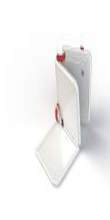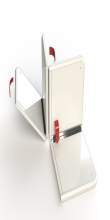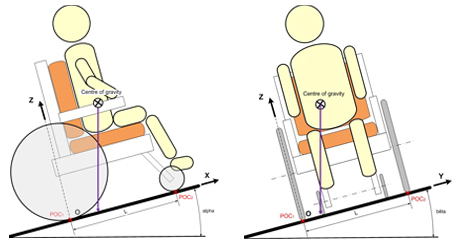WheelSense


WheelSense is a portable, easy to use, simple approach to measuring the stability and centre of gravity of wheelchair systems.
The new wheelchair stability assessment system, WheelSense, predicts the stability of scooters and wheelchairs. The issue of stability is of crucial importance in allowing a user to get the most from their wheelchair while maintaining safety. Stability problems can arise, for example, after modifications to the wheelchair and the installation of additional equipment that changes the original position of the centre of gravity. User behaviour also plays a part in the stability of the chair, so understanding the limits of the chair is important in the education of users and carers.
The system is made up of a folding platform and measurement software used via the graphical user interface (GUI).
The platform set-up process is very straightforward; it simply unfolds.




The platform is lightweight and compact, folding out into a simple surface onto which the chair can be rolled easily. The design of the platform aims to be simple to use, and provides a smoother experience for wheelchair occupants by removing the need for inclines during the test. The folding mechanism alongside the reduced manual handling for clinicians, allow for a quicker assessment yet with enhanced accuracy and detail within the measurements.
The GUI ensures a systematic workflow tailored to the needs of the assessment.
The GUI is designed to be intuitive and simple to use; tiles are used to provide a logical sequence to the operation of WheelSense and a straightforward display of the results, to aid clinical decision making. The user follows a series of prompts to make their way through the assessment process; SETUP, MEASURE, SENSE, VIRTUAL RAMP, CLIENT, TEST RESULTS 1, CHAIR, SEATING, USAGE, TUNING TOOLKIT, and CONFIDENCE OF REASONING. By following these steps (each associated with a separate screen, and some optional), the user is able to incorporate a vast amount of information into the measurement, and therefore model the chair’s centre of gravity and behaviour with enhanced accuracy. The CONFIDENCE OF REASONING tile calculates the detail of information available to the user to aid them in clinical reasoning. Thus, the higher the level of detail, the stronger the confidence of reasoning.
WheelSense is part of an ongoing collaborative research project
HDTI, in collaboration with the Faculty of Engineering, Environment and Computing and Faculty of Arts and Humanities, have been awarded funding from the National Institute for Health Research under the Invention for Innovation (i4i) scheme to develop a system for measuring and improving wheelchair performance.
The project involves prescribers, suppliers, wheelchair users, the Medicine and Healthcare Products Regulatory Agency (MHRA) and leading wheelchair manufacturers. It is employing user-centred design principles in order to ensure the product has the best chance of being taken to market. The key objective for the Wheel-SAS project is to develop and test a wheelchair centre of gravity measurement system to the point of commercialisation; that is for the project’s associated IP to be licensed or sold to a commercial organisation.
Thus, the project needs to engage with relevant industry to understand the following:
- Which sector of the industry is likely to want such a product in their portfolio?
- What is the most likely business plan to be adopted to achieve required sales?
- What is the industry reaction to the project outcomes so far and what might we need to review in order to maintain industry interest?
The project involves four NHS organisations as partners:
- West Midlands Rehabilitation Centre
- Kings College Hospital NHS Foundation Trust
- Betsi Cadwaladr University Health Board
- Abertawe Bro Morgannwg University Health Board
These partners all have expert knowledge of developing prototype systems and extensive experience meeting the needs of wheelchair users – invaluable resources in a project of this kind.

User-centred Research:
During the project, an iterative approach has been taken to incorporating the views and needs of potential end users of the system. A number of different research methods have provided information about desired functionality, the current state of the market, the attitudes of healthcare professionals toward stability testing and associated equipment, and the branding of the new system.
Thus far, our research has told us that:
- The system should be portable, to accommodate offsite visits, and promote resource sharing among services therefore offering value for money
- The system must be user-friendly to encourage less experienced professionals and those without an engineering background to engage with its use
- The system should be less unpleasant for patients than current methods; ramps are felt to be too steep and can be distressing for the patient, and load cell rigs look technical and intimidating
- Record keeping should be supported
- The system should be flexible in allowing prescribers to either use basic or complicated functions depending on their needs or experience, whilst still supporting the core functionality, i.e. providing an accurate representation of the centre of gravity of the chair in different configurations.
The next phase of the research branch of the project will be a multi-centre evaluation with the NHS partners. Within the evaluation, we will assess the usability and acceptability of the system and identify barriers and enablers to its use in a clinical setting. This phase is due to commence in September 2013 and will be complete by April 2014, after which it is anticipated that a commercial partner will be sought to take the final product to market.
For further information on this project, please contact Dr Dimitar Stefanov from the Faculty of Engineering, Environment and Computing who is the Principal Investigator d.stefanov@coventry.ac.uk, or Simon Fielden, Project Manager hdti.info@coventry.co.uk.




